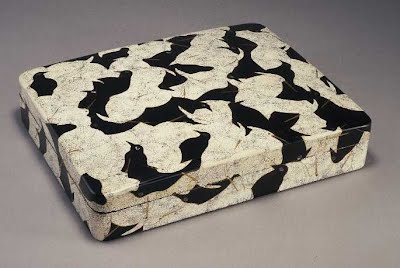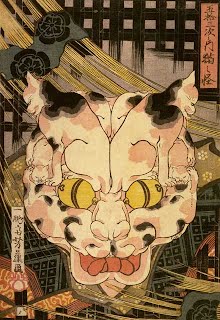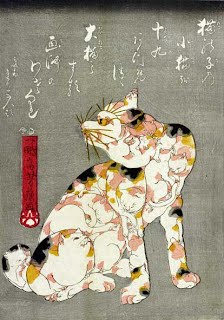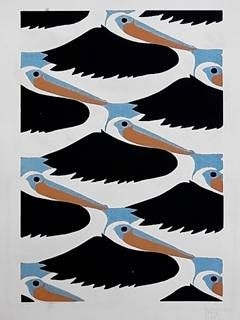Preface This essay is perhaps more prone to revision than others, due to various factors. First, of numerous entries, requiring extensive research. Second, of at times uncertain aspects, due to the respective artists being obscure at times. Third, if I waited until I was completely satisfied with it may otherwise take many years before posting! Therefore, rather than wait any longer, with the danger of it never materialising I have decided to post, of which I will revise at my leisure. Although not an ideal situation, it is nonetheless a considered piece, researched to my high standards, and more than suitable for web, but not as a defining article in print. Introduction Although Escher is widely credited as the first person to undertake tessellation of recognisable animal motifs, with the first dated instance of 1920 or 1921, as in ‘Escher-like tessellations’ (nearly all of which will served as the standard model), without gaps, overlaps or ‘space fillings’ this is not actually so. There are indeed precursors, or near contemporaries, to greater, or more typically, to lesser degrees. Note that this date will serve as the benchmark despite this being only an initial, cursory study, of a handful of tessellations, of which only much later, in 1937, was a concerted study made by Escher. Certainly, he can be regarded as having brought this genre to prominence, but there are indeed forerunners, of various descriptions, albeit their efforts pale in comparison in both quality and number. As can be seen, there are very few indeed, and some here are perhaps of dubious inclusion. However, the task of categorising ‘Escher-like’ is not easily stated as realised! First, the premise, although seemingly obvious, is not exactly straightforward, and so should be set out in detail. For instance, aside from the obvious plane tilings, there are his ‘free plane fillings’, still of a tessellation principle, as evinced by Plane Filling I and Plane Filling II, generically which have become known as ‘Cluster Puzzles’, as so named by Alex Palmer, who was prominent later (1960s) in the field. Should these be included or not? One can argue both for and against here. However, as these possess all the elements of an Escher-like tiling, but without the repeat aspect, I have also decided to include, of which there are also forerunners. I have also decided to include instances of less certain intentions, whereby the above conditions does not strictly apply; with forerunner examples so few in number, I have perhaps lent towards including ‘all’, with relatively minor gaps, overlaps and space fillings, despite at times tenuous instances, some in the extreme. As an aside, it is interesting that Escher himself began by space filling, in 1920 or 1921, with ‘Plane-filling motif with Human Figures’, of two figures inside a repeating rhombus. Fouteen instances are identified, in chronological order, with Escher added to the list for the sake of completeness, with each entry then discussed in detailed and pictured.
Inventory, by Year 1. Pre Columbian art c. 1000 BCE, Pre Inca cultures 2. c. 14-15th century Mehmed Siyah Qualem c. 14-15th century album at the Topkapı Palace Museum, Istanbul, Turkey 3. c. 19th century, Shibata Zenshi 4. Yoshifuji Utagawa (1848-1849) 5. 1896, Nellie Syrett 6. 1899, Koloman Moser 7. Late 1890s, Erwin Puchinger 8. Maurice Pillard Verneuil 9. 1903, John Sloan 10. 1908, Margaret Richardson 11. c. 1910, Chris Lebeau 12. c. 1914, Louis Raemaekers, Satirical Maps 13. 1920 or 1921, M. C. Escher (1898-1972) 14. 1921, Hisui Sugiura
As can be seen, the above listing can broadly be divided into two distinct periods; namely that of Art Nouveau, where Escher-like designs began to be prominent, and pre Art Nouveau, where any Escher-like instances were decidedly sporadic, vague, and at times open to intention.
1. Pre Columbian art c. 1000 BCE, Pre Inca cultures For convenience I discuss these together. The nuances require further research on my part, and this part of the essay is more prone to inexactness, not to mention incorrectness than others. I stand to be corrected. However, I will at least make a start, given that the above is often given as the beginning of Escher-like tessellation. Branko Grünbaum in the ‘extra material’ to his paper in M. C. Escher: Art and Science, gives a series of such examples. However, I am not entirely convinced by this. Is the artist designing as to true Escher-like principles? I remain to be convinced. The designs are crude indeed, and to me seem little more than eye additions to a strict geometric pattern. Whether these are patterns or tilings is not clear. The creatures are not easily described, being little more than eyes added to the pattern. Although a case can indeed be made, I consider this extremely weak indeed. Certainly, with such vagueness and uncertainties surrounding these, these cannot be considered as Escher-like. At best, a better description is proto Escher.
2. Mehmed Siyah Qualem c. 14-15th century album at the Topkapı Palace Museum, Istanbul, Turkey Mehmed Siyah Qualem, of **, although I am uncertain as to what the artist had in mind here. This is arguably the weakest of the candidates, and could arguably be excluded. Although most all of the animals do not possess the ‘double function’ mentioned above, enough do which to me suggests purposeful use here; if it was just once or twice than one could say this was an accidental occurrence. I have had a look on the web for more of this type of work from Qualem, but this appears to be the only instance of a ‘tessellation’ type. further, the image itself has seemingly faded from age, and so casing difficulties in interpretation. Text from the accompanying museum caption: The most famous amongst the albums in the Top Kapi palace are the Mehmed Siyah Qualem collection, depicting monsters and the life of the nomads. There are 64 in all, and their style varies, so they must be from different masters. They are executed in black wash with occasional brushstrokes of faint colour. They come in two sorts, one of demons with human and animal attributes who wrestle, dance, play games and drink, thought to depict shamanistic ideas, where humans wearing masks act like demons. The second show the life of people of the steppes. There are thought to go back to the culture of Transoxania and Turkestan, influenced by Chinese and other Asian civilizations. They are probably from the 14th and 15th century, from an area where Shamanistic ideas were still alive in some sufi orders.
3. c. 19th century, Shibata Zenshi Shibata Zenshi, of Japan, as discussed at the British Museum site: Lidded document box, containing tray. With design of interlocking crows and egrets. Made of wood with black lacquer and crushed eggshell; eyes inlaid in gold lacquer and mother-of-pearl. Rinpa School, Edo Period. This appears to be his only work ‘Escher style’. Reference is made to interlocking crows and egrets, similar in nature to Escher’s plane fillings, although not an exact comparison, as minor overlaps can be seen. A drawback in interpreting this is due to the reflective medium, with the photos not of the greatest clarity. Although the crows are perhaps the more readily identifiable, I struggle mostly to define the egrets at all! However, there does indeed appear to be a principle of, as Escher stated in conjunction with his tessellations, of a line ‘… serving a double function’. However are both birds weak in silhouette, and with occasional overlaps, and so quite what the artist had in mind is unclear. Further to the above, crows and egrets are a common motif in Japanese arts, both pictorially and in literature. Creative Commons Attribution-NonCommercial-ShareAlike 4.0 International (CC BY-NC-SA 4.0) license 4. Yoshifuji Utagawa (1848-1849)
5. 1899, Koloman Moser (1868-1918) Without a shadow of doubt, Koloman Moser, an Art Nouveau artist, can be considered as the first true Escher-like artist. In contrast to the above vagueness and uncertainties, there can be seen to be a concerted attempt to design as according to Escher principles. Prominent among these is Trout Dance. There are also many other instances, albeit some of which have slightly more leeway, with minor gaps and overlaps, but even here, are undoubtedly designed as to tessellation principles. Indeed, the Art Nouveau period seems to have spurred an interest in Escher-like tessellations, as at least two other practitioners also designed as according to Escher principles, with Erwin Puchinger and M. P. Vernueil, as detailed below.
6. Nellie Syrett (1882-1961) A cover for The Yellow Book, October 1896. Described as ‘six cherubs with birds flying around them’. As noted by Andrew Crompton, who wrote about this work in ‘Lifelike Tessellations’, describing it as a ‘larval tessellation’. The shortcoming here is that of (relatively minor) overlapping shapes. Again, as with many others here, quite what the artist is intending is unclear. I consider this as a forerunner most weak indeed, and barely worth including. Upon research, I could not find any other such instances by her.
7. Late 1890s, Erwin Puchinger (1875-1944) Erwin Puchinger, of the Vienna secessionists, was a contemporary of Moser, and indeed were colleagues at Vienna, although which artist likely influenced the other is unclear. However, his work in this field is decidedly pales in comparison with Moser’s, with only a few instances, and furthermore, and not all are quite true to tessellation principles, with introduced indentations and overlaps and space fillings. Whether he was designing as to a tessellation principle is unclear. In particular, see Carnival. Nonetheless, his work is, with due reservation, is quite good.
8. 1897? Maurice Pillard Verneuil (1869-1942) L’Animal dans la Decoration, plate 11. Introduction by M. E. Grasset. Maurice Pillard Verneuil (1869-1942), a leading Art Nouveau artist Again, somewhat weak, with introduced indentations. However, this is still of a broad tessellation principle, with appropriate reservation.
9. 1903, John French Sloan (1871-1951) John French Sloan (1871-1951) has but a single instance, of the cluster puzzle (free plane filling type), albeit with the occasional forced indentation, titled Blackbird. Sloan was a well-known painter of the twentieth century Ashcan school of American art. Aside from this, between 1903 and 1910, he produced a series of puzzle articles for the Philadelphia Inquirer, one of which can be termed a forerunner to cluster puzzles, with ‘Blackbird’ puzzle, of 1903. Quite how to assess this artwork as regards to the genre is fraught with difficulty, as the premise of a double contour line throughout is weakened, to a greater or lesser degree. However, the drawing still remains cluster puzzle in intent, if not ideally so.
10. c. 1909, Margaret Richardson/Mrs Hayden Richardson (1876-1948) Margaret Hayden Richardson (1876-1948) of New York City, USA, also has a single instance, of the cluster puzzle (free plane filling type), and although here in contrast to Sloan, above, this is without gaps, and adheres to the true tessellation principle of no gaps, with ‘A Bad Dream’, a jigsaw with 90 pieces. This is, pleasingly is unambiguous as to intent. This puzzle is thus noteworthy on historical grounds. Further, it has a large number of pieces, with a typical puzzle from others much less. The background to the designing of the puzzle is unknown, as indeed is largely of Richardson herself. The only background detail I have of her is that she was a jigsaw puzzle designer, branded as ‘Perplexity’ puzzles, between 1908 and 1910. Richardson was a prominent figure in the jigsaw puzzle community with other, ‘standard’ puzzles, but it would appear that this is the only instance of the genre that she did. Further, the puzzle is as scarce as can be; there is only one known instance extant, and so possibly this is indeed a one-off. Speculating, possibly this is the only one that there is. Given that this is not mass-produced (i.e. the design was hand drawn), likely there were few, if any more produced, given the number of pieces and detail required. However, it is not entirely clear if Richardson was indeed the designer, or merely the head of operations. She owned a house frequented by artists, and is not known to have any interest in art or left any artwork behind, as might have been expected. Possibly, was of the artist house residents designed this.
11. Chris Lebeau c. 1910 (1878-1945) Chris Lebeau (1878-1945), a Dutch designer, painter draughtsman and teacher, is credited as a Escher precursor in The World of M. C. Escher, p. 22, with a detail of a poster, of fish around the border. Indeed, this is the only reference I have of Lebeau from an Escher source. However, there are also further works of his, with more of a tessellation like intent, such as Insects and fish. However, thee can be seen to be many faux articulations, with introduced indentations, with the motifs more of a space filling nature that of interlocking.
12. c. 1914, Louis Raemaekers et al, Satirical Maps (1869-1956) A vogue in cartography, namely with what is termed as ‘satirical maps’, popular in 1914 at the outbreak of the First World War, can also on occasion be described loosely as ‘Escher-like’. The genre draws upon national symbols and stereotypes, such as a British bulldog, Russian bears etc., with each figure broadly filling out their respective country outline to greater or lesser degrees. Some, but by no means all, consist of loose Escher-like tessellation aspects (somewhat reminiscent to my recent posting on ‘cluster puzzles’). The best as regards tessellation matters is probably by Louis Raemaekers, of the Netherlands, titled ‘Het Gekkenhuis’, translated approximately as ‘The Lunatic Asylum’. Raemaekers was an artist of some renown, said to be the best-known propaganda cartoonist of the First World War (although I was previously unaware of him). This is the only ‘tessellation’ instance of his I have found. His work was apparently common knowledge in the Netherlands, and indeed worldwide. It would be interesting to know if Escher knew of this particular work. I am unfamiliar with any reference in this regard. For general interest, some other instances of note of the genre, but by different artists, are ‘Humoristische Karte von Europa im Jahre 1914’ and ‘Satyrische Europa Karte’. For a general introduction to the genre, see: http://timbryars.tumblr.com/post/14824179535/satirical-maps-of-the-great-war-1914-1915 A web search on ‘satirical maps’ will find many other references. http://timbryars.tumblr.com/tagged/Satirical-maps
13. M. C. Escher 1920 or 1921 (1898-1972) As alluded to above, Escher began in 1920 or 1921, with two periodic drawings, and a few space fillings. The exact date is uncertain, as recorded latterly (in the late 1930s?) by Escher on his periodic drawings. Although here he uses a relatively complex tiling arrangement, not typically undertaken by a beginner, perhaps a crumb of comfort to the tyro is that these are not very good! Therefore, to any beginner, do not be too discouraged if your early efforts are of a like nature. We have all been there. Do persevere! 14. Hisui Sugiura, 1921 (1876-1965) Hisui Sugiura was a Japanese graphic designer who was a pioneer of modern Japanese graphic design. His work is mostly figurative, with an seemingly occasional interest in pattern, broadly stated. However, his interest in tessellation was slight indeed, with seemingly only one instance, of Pelicans. Does anyone know of other possible instances for inclusion? I would be delighted to hear from you. As discussed above, I am more than willing to overlook, to a degree, ideal instances.
References
Anonymous. ‘The Yellow Book’. An Illustrated Quarterly. Vol. XI October, 1896. John Lane, The Bodley Head Ballantyne Press. London and New York. London & Edinburgh
Crompton, Andrew. ‘Lifelike Tessellations’. In Manchester Architectural Papers 2000, edited by Geoff McKennan, pp. 17-24 Shibata Zenshi. http://www.britishmuseum.org/research/collection_online/collection_object_details.aspx?objectId=8798&partId=1 Created 9 October 2018. Hisui Sugiura added 6 May 2019 |




